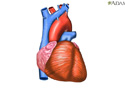Aortic arch syndrome
Subclavian artery occlusive syndrome; Carotid artery occlusion syndrome; Subclavian steal syndrome; Vertebral-basilar artery occlusive syndrome; Takayasu disease; Pulseless diseaseThe aortic arch is the top part of the main artery carrying blood away from the heart. Aortic arch syndrome refers to a group of signs and symptoms associated with structural problems in the arteries that branch off the aortic arch.
Causes
Aortic arch syndrome problems can be due to trauma, blood clots, or malformations that develop before birth. These defects result in abnormal blood flow to the head, neck, or arms.
In children, there are many types of aortic arch syndromes, including:
- Congenital absence of a branch of the aorta
- Isolation of the subclavian arteries
-
Vascular rings
Vascular rings
Vascular ring is an abnormal formation of the aorta, the large artery that carries blood from the heart to the rest of the body. It is a congenital ...
 ImageRead Article Now Book Mark Article
ImageRead Article Now Book Mark Article
An inflammatory disease called Takayasu syndrome may result in narrowing (stenosis) of the vessels of the aortic arch. This typically occurs in women and girls. This disease is seen more often in people of Asian descent.
Symptoms
Symptoms vary according to which artery or other structure that has been affected. Symptoms may include:
- Blood pressure changes
- Breathing problems
- Dizziness, blurred vision, weakness, and other brain and nervous system (neurological) changes
- Numbness of an arm
- Reduced pulse
- Swallowing problems
-
Transient ischemic attacks (TIA)
Transient ischemic attacks (TIA)
A transient ischemic attack (TIA) occurs when blood flow to a part of the brain stops for a brief time. A person will have stroke-like symptoms for ...
 ImageRead Article Now Book Mark Article
ImageRead Article Now Book Mark Article
Treatment
Surgery is often needed to treat the underlying cause of aortic arch syndrome.
References
Braverman AC, Schermerhorn M. Diseases of the aorta. In: Libby P, Bonow RO, Mann DL, Tomaselli GF, Bhatt DL, Solomon SD, eds. Braunwald's Heart Disease: A Textbook of Cardiovascular Medicine. 12th ed. Philadelphia, PA: Elsevier; 2022:chap 42.
James WD, Elston DM, Treat JR, Rosenbach MA, Neuhaus IM. Cutaneous vascular diseases. In: James WD, Elston DM, Treat JR, Rosenbach MA, Neuhaus IM, eds. Andrews' Diseases of the Skin: Clinical Dermatology. 13th ed. Philadelphia, PA: Elsevier; 2020:chap 35.
Langford CA. Takayasu arteritis. In: Hochberg MC, Gravallese EM, Smolen JS, van der Heijde D, Weinblatt ME, Weisman MH, eds. Rheumatology. 8th ed. Philadelphia, PA: Elsevier; 2023:chap 165.
-
Heartbeat
Animation
-
Heart - section through the middle - illustration
The interior of the heart is composed of valves, chambers, and associated vessels.
Heart - section through the middle
illustration
-
Vascular ring - illustration
Vascular ring is a term used to describe a number of abnormal formations of the aorta, the large artery that carries blood from the heart to the rest of the body, or of the pulmonary artery. The abnormal vessel(s) forms a ring, which encircles and may press down on the windpipe (trachea) or the esophagus. The additional pressure on the windpipe (trachea) and esophagus can lead to breathing and swallowing problems.
Vascular ring
illustration
-
Heart - section through the middle - illustration
The interior of the heart is composed of valves, chambers, and associated vessels.
Heart - section through the middle
illustration
-
Vascular ring - illustration
Vascular ring is a term used to describe a number of abnormal formations of the aorta, the large artery that carries blood from the heart to the rest of the body, or of the pulmonary artery. The abnormal vessel(s) forms a ring, which encircles and may press down on the windpipe (trachea) or the esophagus. The additional pressure on the windpipe (trachea) and esophagus can lead to breathing and swallowing problems.
Vascular ring
illustration
Review Date: 5/8/2024
Reviewed By: Thomas S. Metkus, MD, Assistant Professor of Medicine and Surgery, Johns Hopkins University School of Medicine, Baltimore, MD. Also reviewed by David C. Dugdale, MD, Medical Director, Brenda Conaway, Editorial Director, and the A.D.A.M. Editorial team.






